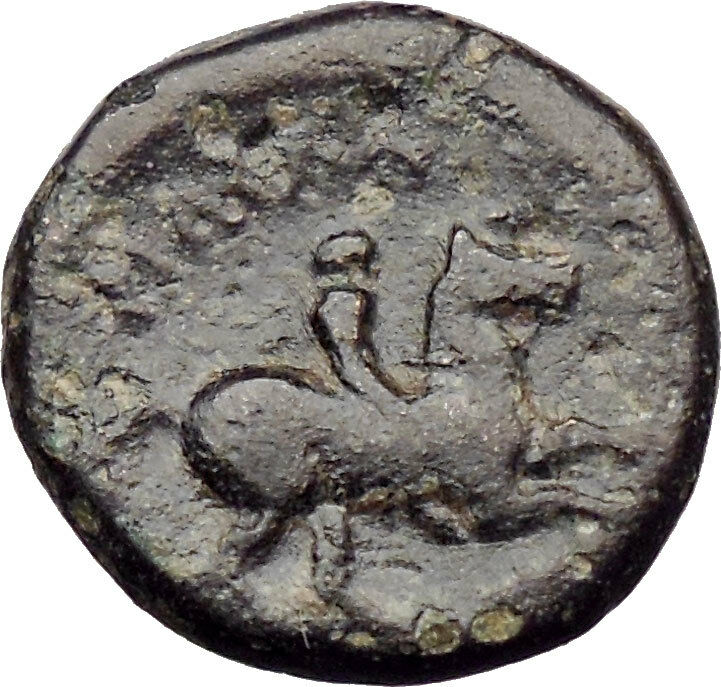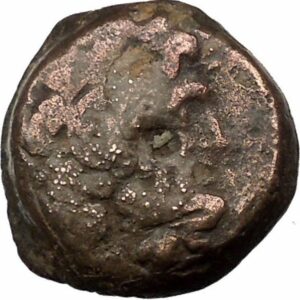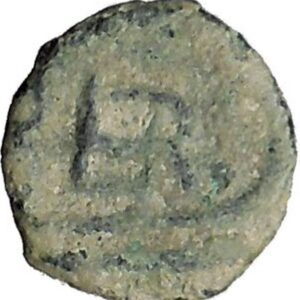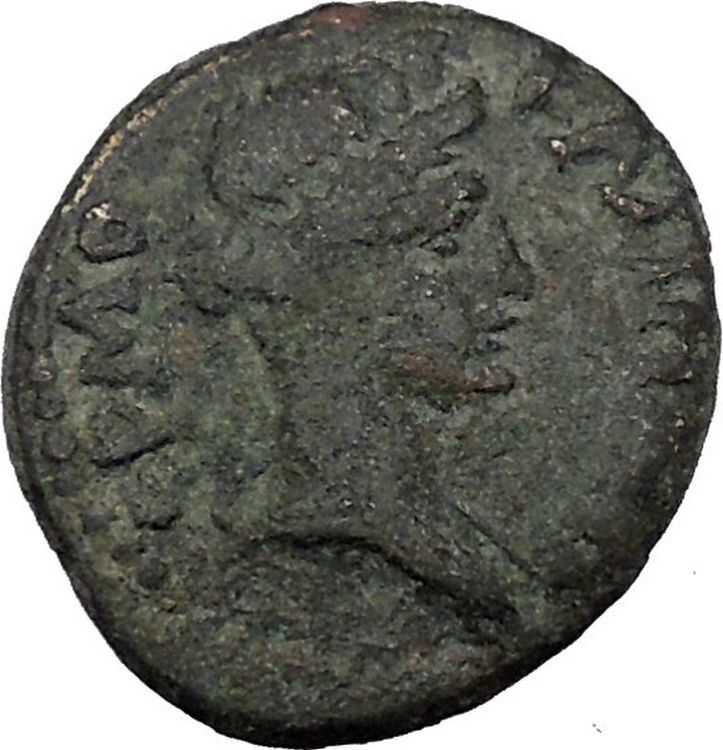|
Greek Coin of
Seleukid Kingdom
Alexander II Zabinas – Reigned: 128-123
B.C.
Bronze 20mm (5.86 grams) Antioch mint, struck circa 128-123 B.C.
Reference: Sear 7125; B.M.C. 4.82, 16; HGC 9, 1161; SC 2229
His diademed head right.
ΒΑΣΙΛΕΩΣ / ΑΛΕΞΑΝΔΡΟΥ either side of young Dionysos standing left, holding
kantharos
and thyrsos; in field to left, Σ and Seleucid date.
Claiming to be an adopted son of Alexander Balas, Zebina
rebelled against Demetrios II with the backing of Ptolemy VII of Egypt. Five
years later he was defeated by the forces of Cleopatra and her son Antiochos
VIII.
You are bidding on the exact item pictured,
provided with a Certificate of Authenticity and Lifetime Guarantee of
Authenticity.

Red-figure
kantharos,
National Archaeological Museum of Athens
.
A kantharos (Greek κάνθαρος) or cantharus is a type of
Greek pottery
used for drinking. It is
characterized by its high swung handles which extend above the lip of the pot.
The god Dionysus
had a kantharos which was never empty.

Geometric
kantharos
In
Greek mythology
, a thyrsus or thyrsos
(Greek:
θύρσος
) was a staff of
giant fennel
(Ferula communis) covered
with ivy
vines and leaves, sometimes wound with
taeniae
and always topped with a
pine
cone
. These staffs were carried by
Dionysus
and his followers.
Euripides
wrote that
honey
dripped from the thyrsos staves that the
Bacchic
maenads
carried.The thyrsus was a sacred
instrument at religious rituals and
fêtes.
Symbolism
The thyrsus, associated with
Dionysus
(or Bacchus) and his followers, the
Satyrs
and
Maenads
, is a symbol of
prosperity
,
fertility
,
hedonism
, and pleasure/enjoyment in general. It
has been suggested that this was specifically a fertility
phallus
, with the fennel representing the shaft
of the penis and the pine cone representing the “seed” issuing forth. The
thyrsus was tossed in the Bacchic dance:
Pentheus: The thyrsus— in my right hand shall I hold it?
-
- Or thus am I more like a Bacchanal?
Dionysus: In thy right hand, and with thy right foot raise it”
Sometimes the thyrsus was displayed in conjunction with a
kantharos
wine cup, another symbol of Dionysus,
forming a male-and-female combination like that of the royal scepter and orb.
Literature
In the Iliad
,
Diomedes
, one of the leading warriors of the
Achaeans
, mentions the thyrsus while speaking
to
Glaucus
, one of the
Lycian
commanders in the
Trojan army, about
Lycurgus
, the king of
Scyros
:
He it was that/drove the nursing women who were in charge/of frenzied
Bacchus through the land of Nysa,/and they flung their thyrsi on the ground
as/murderous Lycurgus beat them with his ox-/goad. (Iliad, Book
VI.132-37)
The thyrsus is explicitly attributed to Dionysus in
Euripides
‘s play
The Bacchae
as part of the costume of the
Dionysian cult.
…To raise my Bacchic shout, and clothe all who respond/ In fawnskin
habits, and put my thyrsus in their hands–/ The weapon wreathed with
ivy-shoots…” Euripides also writes, “There’s a brute wildness in the
fennel-wands—Reverence it well.” (The Bacchae and Other Plays, trans.
by Philip Vellacott, Penguin, 1954.)
Socrates
writes in
Phaedo
:
I conceive that the founders of the mysteries had a real meaning and were
not mere triflers when they intimated in a figure long ago that he who
passes unsanctified and uninitiated into the world below will live in a
slough, but that he who arrives there after initiation and purification will
dwell with the gods. For “many,” as they say in the mysteries, “are the
thyrsus bearers, but few are the mystics,”–meaning, as I interpret the
words, the true philosophers.
In Part II of
Johann Wolfgang von Goethe
‘s
Faust
,
Mephistopheles
tries to catch a
Lamia
, only to find out that she is an
illusion:
Well, then, a tall one I will catch…/And now a thyrsus-pole I
snatch!/Only a pine-cone as its head. (7775-7777)
Sookie Stackhouse notes the thyrsus carried by the maenad in the 2nd book of
The Southern Vampire Mysteries
.
She idly waved the long wand with the tuft on the end. It was called a
thyrsis [sic];
I’d looked maenad up in the encyclopedia. Now I could die educated. (Harris,
Charlaine (2006-09-01). “Living Dead in Dallas: A Sookie Stackhouse Novel”}
Gallery
-
A Bacchant holding a thyrsus: Malice, by
William-Adolphe Bouguereau
, 1899
-
Roman relief showing a Maenad holding a thyrsus (Prado,
Madrid
).
-
Bacchus Triumphant (1882)
by
John Reinhard Weguelin
-
A Maenad uses her thrysos to ward off a Satyr,
Attic red-figure
kylix
, circa 480 BC
Dionysus
is the god of the
grape harvest, winemaking and wine, of ritual madness, fertility, theatre and
religious ecstasy in
Greek mythology
. Alcohol, especially
wine, played an important role in Greek
![2nd century Roman statue of Dionysus, after a Hellenistic model (ex-coll. Cardinal Richelieu, Louvre[1])](https://upload.wikimedia.org/wikipedia/commons/thumb/8/8a/Dionysos_Louvre_Ma87_n2.jpg/200px-Dionysos_Louvre_Ma87_n2.jpg)
culture
with Dionysus being an important reason for this life style. His name, thought
to be a theonym
in
Linear B
tablets as di-wo-nu-so (KH
Gq 5 inscription), shows that he may have been worshipped as early as c.
1500–1100 BC by
Mycenean Greeks
; other traces of the
Dionysian-type cult have been found in ancient
Minoan Crete
. His origins are uncertain, and
his cults took many forms; some are described by ancient sources as Thracian,
others as Greek. In some cults, he arrives from the east, as an Asiatic
foreigner; in others, from
Ethiopia
in the South. He is a god of
epiphany
, “the god that comes”, and his
“foreignness” as an arriving outsider-god may be inherent and essential to his
cults. He is a major, popular figure of
Greek mythology
and
religion
, and is included in some lists of the
twelve Olympians
. Dionysus was the last god to
be accepted into Mt. Olympus. He was the youngest and the only one to have a
mortal mother. His festivals were the driving force behind the development of
Greek theatre
. He is an example of a
dying god
.
The earliest cult images of Dionysus show a mature male, bearded and robed.
He holds a fennel
staff, tipped with a pine-cone and known
as a thyrsus
. Later images show him as a
beardless, sensuous, naked or half-naked androgynous youth: the literature
describes him as womanly or “man-womanish”. In its fully developed form, his
central cult imagery shows his triumphant, disorderly arrival or return, as if
from some place beyond the borders of the known and civilized. His procession
(thiasus)
is made up of wild female followers (maenads)
and bearded
satyrs
with
erect penises
. Some are armed with the
thyrsus, some dance or play music. The god himself is drawn in a chariot,
usually by exotic beasts such as lions or tigers, and is sometimes attended by a
bearded, drunken Silenus
. This procession is presumed to be the
cult model for the human followers of his
Dionysian Mysteries
. In his
Thracian
mysteries, he wears the bassaris
or
fox-skin, symbolizing a new life. Dionysus is represented by city
religions as the protector of those who do not belong to conventional society
and thus symbolizes everything which is chaotic, dangerous and unexpected,
everything which escapes human reason and which can only be attributed to the
unforeseeable action of the gods.
Also known as Bacchus, the name adopted by the
Romans
and the frenzy he induces, bakkheia.
His thyrsus is sometimes wound with ivy and dripping with honey. It is a
beneficent wand but also a weapon, and can be used to destroy those who oppose
his cult and the freedoms he represents. He is also called Eleutherios
(“the liberator”), whose wine, music and ecstatic dance frees his followers from
self-conscious fear and care, and subverts the oppressive restraints of the
powerful. Those who partake of his mysteries are possessed and empowered by the
god himself. His cult is also a “cult of the souls”; his maenads feed the dead
through blood-offerings, and he acts as a divine communicant between the living
and the dead.
In Greek mythology, he is presented as a son of
Zeus and the mortal
Semele
, thus semi-divine or
heroic: and as son of Zeus and
Persephone
or
Demeter
, thus both fully divine, part-chthonic
and possibly identical with
Iacchus
of the
Eleusinian Mysteries
. Some scholars believe
that Dionysus is a
syncretism
of a local Greek nature deity and a
more powerful god from
Thrace
or
Phrygia
such as
Sabazios
or
Zalmoxis
.
Alexander II Zabinas, ruler of the
Greek
Seleucid kingdom
, was a counter-king who emerged in the chaos following the
Seleucidian
loss of
Mesopotamia
to the
Parthians
.
Zabinas was a false Seleucid who claimed to be an adoptive son of
Antiochus VII Sidetes
, but in fact seems to have been the son of an Egyptian
merchant named Protarchus.
Antioch
,
Apamea
, and
several other cities, disgusted with the tyranny of Demetrius, acknowledged the
authority of Alexander. He was used as a pawn by the
Egyptian
king
Ptolemy VIII Tryphon
, who introduced Zabinas as a means of getting to the
legitimate Seleucid king
Demetrius II
, who supported his sister
Cleopatra II
against him in the complicated dynastic feuds of the latter
Hellenistic dynasties.
Zabinas managed to defeat Demetrius II, who fled to
Tyre
and was killed there, and thereafter ruled parts of
Syria
(128 BC-123
BC), but soon ran out of Egyptian support and was in his turn was defeated by
Demetrius’ son
Antiochus VIII Grypus
.
Zabinas fled to the Seleucid capital
Antiochia
,
where he plundered several temples. He is said to have joked about melting down
a statuette of the goddess of victory
Nike
which was held in the hand of a
Zeus statue, saying
“Zeus has given me Victory”. Enraged by his impiety the Antiochenes cast Zabinas
out of the city. He soon fell into the hands of robbers, who delivered him up to
Antiochus, by whom he was put to death, in 122 BC.
The name “Zabinas” means “the purchased slave”, and was applied to him,
deprecatingly, in response to a report that he had been bought by Ptolemy as a
slave. For reasons unknown, Alexander II was the only late Seleucid not to use
epithets on his coins. Several of his coins are extant.
Preceded byy
Antiochus VII Sidetes
|
Seleucid King
128–123 BC |
Succeeded by
Antiochus VIII Grypus
and
|
Seleucid
Empire
Σελεύκεια
Seleúkeia |

|
312 BC–63 BC |
↓
|
|
|
The Seleucid Empire in 301 BC.
|
The Seleucid Empire
was a
Hellenistic
state ruled by the Seleucid dynasty
founded by
Seleucus I Nicator
following the division of
the empire created by
Alexander the Great
. Seleucus received
Babylonia
and, from there, expanded his
dominions to include much of Alexander’s
near eastern
territories. At the height of its
power, it included central
Anatolia
, the
Levant
,
Mesopotamia
,
Kuwait
,
Persia
,
Afghanistan
,
Turkmenistan
, and northwest parts of
India
.
The Seleucid Empire was a major center of
Hellenistic
culture that maintained the
preeminence of
Greek
customs where a Greek-Macedonian
political elite dominated, mostly in the urban areas. The Greek population of
the cities who formed the dominant elite were reinforced by emigration from
Greece
. Seleucid expansion into
Anatolia
and Greece was abruptly halted after
decisive defeats
at the hands of the
Roman army
. Their attempts to defeat their old
enemy
Ptolemaic Egypt
were frustrated by Roman
demands. Much of the eastern part of the empire was conquered by the
Parthians
under
Mithridates I of Parthia
in the mid-2nd century
BC, yet the Seleucid kings continued to rule a
rump state
from
the Seleukid Kingdom
until the invasion by
Armenian
king
Tigranes the Great
and their ultimate overthrow
by the Roman
general
Pompey
.
|












![2nd century Roman statue of Dionysus, after a Hellenistic model (ex-coll. Cardinal Richelieu, Louvre[1])](https://upload.wikimedia.org/wikipedia/commons/thumb/8/8a/Dionysos_Louvre_Ma87_n2.jpg/200px-Dionysos_Louvre_Ma87_n2.jpg)




